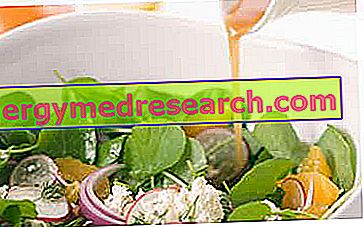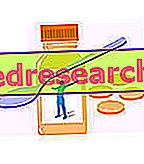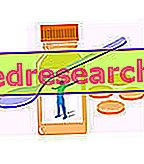Mineral salt requirements
In feeding the cross-country skier, reaching the ration of mineral salts is the most difficult aspect to deal with; for those who move 1.0-3.0 liters of water per day with just sweating, the need for potassium and magnesium increases significantly.

NB . It is essential that the intake of salts is CONSTANT because, unlike water, they need much more time to move around in the various compartments of the body.
First of all, keep in mind that through sweating you can lose up to 10% or more of your body weight, even increasing the risk of collapse or death! Fortunately, in sports (except for extreme competitions such as the 100km of the Sahara) these are more unique than rare, while losses of 2 to 5% are much more frequent. For a cross-country skier of 70kg, sweating and losing 1.5kg (-2%) of liquids means starting to feel a strong sense of thirst, accompanied by a principle of "oppression" and general malaise; reaching -3.5kg (-5%) he will inexorably meet a performance decline that reaches 30% of the personal average, associated with increased perception of effort, appearance of skin spots, drowsiness, apathy, nausea and decreased concentration and emotional stability.
To estimate more accurately the real needs of sodium, chlorine, potassium and magnesium to be respected in the feeding of the cross-country skier, a couple of numbers should be taken into consideration; first, we expose the water / salt ratio in the sweat loss:
| QUANTITIFICATION OF HYDRO-SALINE LOSSES WITH SPORT | |
Water loss (ml) | Loss of salts (g) |
900 | 1.5 |
1800 | 3.0 |
2700 | 4.5 |
3600 | 6.0 |
9000 | 7.5 |
9900 | 9.0 |
secondly, it is appropriate to highlight the relationship between the salts themselves dispersed through sweating:
| REPORT OF ELECTROLYTES IN THE SOUTH - AVERAGE VALUES | |||
Sodium (Na) | Chlorine (Cl) | Potassium (K) | Magnesium (Mg) |
10-60% | 30-50% | 4-5% | 0.02 to 6% |
Availability of the Athlete
Understand the availability (temporal - logistical - organizational and economic) of the athlete and evaluate the relevance of food supplements
As anticipated, the feeding - diet of the cross-country skier has several purposes but (without going around it), by practicing it, the interested subject intends to improve (directly or indirectly) his own performance of the tender. It follows that, before anything else, the feeding of the cross-country skier must be a REALLY APPLICABLE food scheme, whose setting does not disregard the subject's compliance.
Unfortunately, not all athletes are champions, consequently not all athletes (indeed, on the contrary ...) are professionals who are duly remunerated to compete in competitive circuits. Most cross-country skiers have a common working activity (or, at best, student) and live in a family context ... two variables that require meticulous management of the temporal, logistic, organizational and economic resources of the case.
Time resources: anyone who is lucky enough to do a full-time job, nowadays, certainly cannot afford to compromise it in order to better manage his own nutrition aimed at sports. This means that, by setting the diet, it is necessary to use food (or, if necessary, supplements) that are easy to prepare, easy to transport and easy to preserve ... even more so if meal management is assigned (which task ungrateful) to any partner or cohabiting parent who, for his part, would certainly have many other priority activities!
Economic resources: once again, the success of the food scheme depends on its sustainability; of course, any professional would suggest preferring organic foods, specific and unique products of their kind, or food supplements prepared with latest generation technologies, to the advantage of strategy effectiveness and overall nutritional quality. On the other hand, it is not possible to ignore the real economic possibilities of the average sportsman; it would be useless, and even frustrating as well as embarrassing, to set the diet - the sportsman's diet preferring foods and supplements that are out of their own (or other) economic possibilities; so watch the price!
Relevance of food supplements: anyone who is constantly updated in the nutritional field, will certainly have noticed that, from time to time, new molecules are discovered or are useful or essential for the human body. Well, in virtue of the nutraceutical power of the various molecules (eg phytocomplexes), it is ALWAYS appropriate to prefer foods (possibly raw and little processed) rather than food supplements. On the other hand, it is often necessary to cover some specific dietary needs of the diet - the diet of the cross-country athlete through the use of "powders and tablets" which, in addition to having greater practicality, shelf life and ease of use, disregard the presence of possible ANTINUTRITIONAL MOLECULES. This is the case with cereals, legumes, fruit and vegetables; it would not be appropriate to exceed with foods particularly rich in oxalic acid and phytates since they would perform a chelating action towards iron, calcium, zinc and selenium; without considering that the fiber is responsible for the slowing down of the digestive and absorption processes (bad requirements of the foods to be consumed before, during and immediately after the performance). In this case, to ensure a sufficient intake of potassium and magnesium (most important elements in the food groups listed above), it is advisable to choose saline-type food supplements ... perhaps associated with a maltodextrin (or vitargo). The latter, not counting fiber (instead typical of highly energetic foods such as cereals and legumes), boasts a major energy-metabolic efficacy; it is advisable to dilute salts and maltodextrins or vitargo in mildly hypotonic and fresh solutions, to be consumed before, during and after the performance, in order to guarantee the restoration of the overall hydration. Obviously, even in this case it is appropriate to consider the price of the supplements to be consumed.



